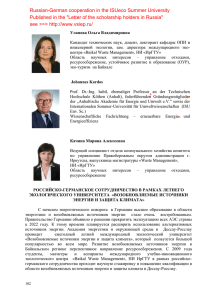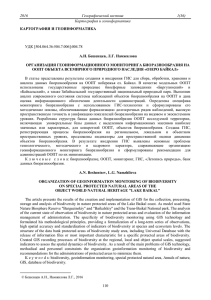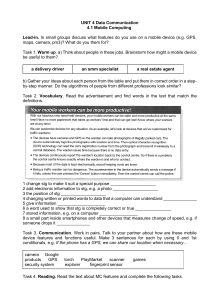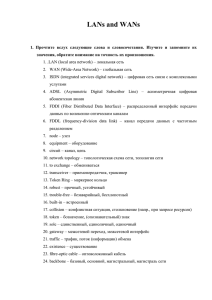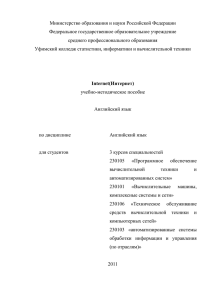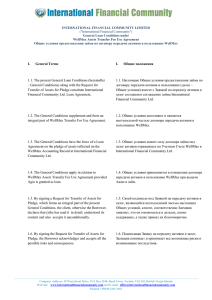Study of the level of total electron content disturbance in the middle-latitude
advertisement

Study of the level of total electron content disturbance in the middle-latitude and Arctic regions by GPS data Natalia P. Perevalova (1), Ilya K. Edemskiy (1), Olga V. Timofeeva (1, 2), Darya D. Katashevtseva (1, 2), Anna S. Polyakova (1) (1) Institute of Solar-Terrestrial Physics, SB RAS (2) Irkutsk State University Bolshie Koty, Russia Total Electron Content (TEC) The total electron content I is the electron density Ne integrated along a beam: 𝑺𝒕𝒐𝒑 𝑰= 𝑵𝒆 𝒅𝒔 𝑺𝒃𝒐𝒕 TEC calculation using the phase measurements at two GNSS frequencies: 𝟏 𝒇𝟏 𝟐 𝒇𝟐 𝟐 𝑰= 𝑳𝟏 𝝀𝟏 − 𝑳𝟐 𝝀𝟐 + 𝒄𝒐𝒏𝒔𝒕𝟏,𝟐 + 𝝈𝑳 𝟒𝟎. 𝟑𝟎𝟖 𝒇𝟏 𝟐 − 𝒇𝟐 𝟐 where 𝑳𝟏 𝝀𝟏 и 𝑳𝟐 𝝀𝟐 is the phase path increments of the radio signals; 𝑳𝟏 = 𝜟𝝋 𝜟𝝋 𝟐𝝅 and 𝑳𝟐 = 𝟐𝝅 , phase measurements by GNSS-receiver made at frequencies of f1 and f2 ; 𝒄𝒐𝒏𝒔𝒕𝟏,𝟐 , ambiguity of phase measurements; 𝝈𝑳, phase measurement error. Baikal School, 2015 2 WTEC index GPS/GLONASS station exercises control of TEC variations in a radius of 5001000 km; The time observation of a GPS satellite at the station is about 2-6 hours. WTEC is multi-day series of averaged TEC disturbance [Berngardt O.I., Voeykov S.V., Ratovsky K.G. Using a single GPS/GLONASS receiver for estimating the level of ionospheric disturbance // XXXI URSI General Assembly and Scientific Symposium. Beijing, China. August 16-23, 2014: abstracts. 2014. GP2.31] Baikal School, 2015 3 Measurement data for 2013 Filtration period: 01-10 minutes medium-scale ionospheric disturbances; 01-40 minuteslarge-scale ionospheric disturbances. Planetary geomagnetic indexes: AE characterizes high latitudes; Dst, low latitudes; Kp, middle latitudes. Baikal School, 2015 4 WTEC variations in March and June, 2013 middle-latitudes high-latitudes geomagnetic indexes The WTEC variations for two ranges of periods (01-10 min, 01-40 min) at the NRIL, MOND, ORDA stations and behavior of Dst, Kp, AE geomagnetic indexes. The vertical dashed lines indicate sudden storm commencements. Baikal School, 2015 5 Diurnal-seasonal WTEC variations The Diurnal-seasonal WTEC variations for ranges of periods of 01-10 min (a, c) and 01-40 min (b, d) at the NRIL (a, b) and MOND (c, d) stations. The black lines mark sunrise time at 100 km (solid) and 300 km (dashed). ST stands for the solar terminator. Baikal School, 2015 6 CONCLUSIONS In Arctic region The minimal level of disturbance intensity does not depend on the season. WTEC behavior correlates well with the variations in AE index and does less with the behavior of the Dst index. WTEC variations caused by the solar terminator are absent. In middle latitudes Diurnal WTEC variations are particularly pronounced over the year and have also some seasonal features. The minimal level of disturbance intensity in summer is higher than in winter. The solar terminator generates intense large-scale ionospheric disturbances, but does not cause medium-scale ones. Baikal School, 2015 7 THANK YOU FOR YOUR ATTENTION! Baikal School, 2015 8 nT Time (t) Day of the year (UT) Baikal School, 2015 9 LT, h Solar terminator 2013, days Baikal School, 2015 10 Solar terminator Baikal School, 2015 11 Радиосигналы в ГНСС GPS и ГЛОНАСС Все спутники GPS передают сигналы на двух одинаковых частотах: f1 = 1575.42МГц и f2= 1227.60МГц Спутники ГЛОНАСС передают сигналы на разных частотах в двух диапазонах. Первый диапазон имеет центральную частоту f01= 1602 МГц, частота передачи спутников определяется по формуле: f1k=f01+k*Δf1 где Δf1=0,5625 МГц, k - номер частотного канала (k=-7,-6,-5,...0,...). Второй диапазон имеет центральную частоту f02 = 1246 МГц, частота передачи спутников определяется по формуле: f2k=f02+k* Δf2 где Δf2=0.4375 МГц, k - номер частотного канала (k=-7,-6,-5,...0,...). Baikal School, 2015 12
